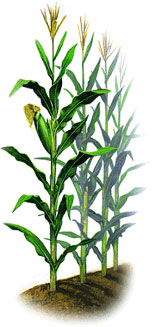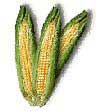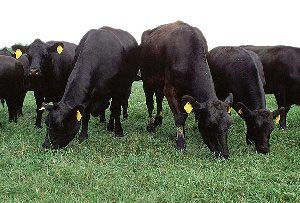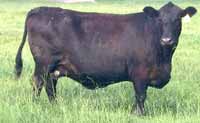Kentucky Pest News Newsletter
HIGHLIGHTS IN THIS ISSUE
Number 1153__________February 25, 2008
TOBACCO
CORN
FRUIT
LIVESTOCK

TOBACCO
PREVENTIVE CONTROL OPTIONS FOR TOBACCO APHIDS
By Lee Townsend
 The very successful preventive approach to aphid control on tobacco is based on the use of neonicotinoid class insecticides- clothianidin (Belay), imidacloprid (Admire), and thiamethoxam (Platinum). The mode of action of these insecticides is similar to that of nicotine, which acts on the central nervous system of insects to produce nerve excitation and the paralysis leading to death. Their solubility in water allows for uptake and movement in plants, giving them a significant systemic effect, especially on sap feeding insects such as aphids. Slow breakdown in the plant gives long term pest control. These products belong to the 4a group based on mode of action.
The very successful preventive approach to aphid control on tobacco is based on the use of neonicotinoid class insecticides- clothianidin (Belay), imidacloprid (Admire), and thiamethoxam (Platinum). The mode of action of these insecticides is similar to that of nicotine, which acts on the central nervous system of insects to produce nerve excitation and the paralysis leading to death. Their solubility in water allows for uptake and movement in plants, giving them a significant systemic effect, especially on sap feeding insects such as aphids. Slow breakdown in the plant gives long term pest control. These products belong to the 4a group based on mode of action.
UK tobacco insecticide evaluations have shown Belay, Admire, and Platinum to provide excellent preventive aphid control by tray drench or transplant water application compared to untreated tobacco. No statistical differences have been seen between products or application methods more than 60 following transplant and no statistical differences have been seen in aphid control using low or high label rates.
| Insecticide Rate |
| Clothianidin |
Belay 16% WSG |
10 oz per acre |
| Imidacloprid |
Admire 2F - 2 lbs/gal |
1 fl oz/1,000 plants - tray drench
1.4 fl oz/1,000 plants - transplant water |
| Imidacloprid |
Admire Pro - 4.6 lbs/gal |
0.6 f l oz/1,000 plants - tray drench
0.8 fl oz/1,000 plants - transplant water |
| Thiamethoxam |
Platinum - 2 lbs/gal |
0.8 to 1.3 fl oz/1,000 plants |
Belay 16 WSG (Arysta Lifescience) lists aphid and flea beetle control. Caution: Causes moderate eye irritation. Soil applications may sometimes cause yellowing of foliage present at the time of transplanting. This effect does not have any impact on growth and yields.
Admire 2F and Admire Pro (Bayer) lists mole crickets (no problem in Ky), whiteflies (no problem in Ky), and wireworms, plus suppression of cutworms and tomato spotted wilt virus at higher rates. Apply as a tray drench not more than 7 days prior to transplanting. Generic imidacloprid products are available, such as Alias 2FM and Couraze 2F.
Platinum (Syngenta) lists flea beetle, Japanese beetle, thrips, and wireworm control. Apply as a tray drench not more than 2 days prior to transplanting. During transplanting, workers handling plants must wear waterproof gloves.
General Considerations for these Insecticides
Plants in flats or trays should be watered from above immediately after the application to wash the product from the foliage into the potting media. Failure to wash the formulation into the root ball may result in reduced control.
These formulations are suspended in water after dilution they will settle if not mixed or agitated regularly. Settling can result in uneven distribution of the insecticide, especially in transplant water applications.
Test compatibility of tank mixes in small, proportionate amounts, watch for poor mixing and formation of precipitates, these are indications of incompatibility.
Insecticide resistance can develop if products with the same mode of action are used repeatedly. Since these three products are 4a insecticides, rotation among them is not an effective resistance management strategy.
For the latest blue mold status and other tobacco disease information, check the KY Blue Mold Warning System online.
 http://www.uky.edu/Agriculture/kpn/kyblue/kyblue.htm
http://www.uky.edu/Agriculture/kpn/kyblue/kyblue.htm

For more information about tobacco pests, visit
"Insect Management Recommendations".

CORN
POSSIBLE LIMITS TO THE VALUE OF SEED-TREATMENT FUNGICIDES IN CORN
By Paul Vincelli
 Pythium species are fungal-like organisms commonly found in agricultural soils. These are the primary
cause of seed rot and seedling damping off in corn in Kentucky, and they are typically most
active in cool, wet soils.
Pythium species are fungal-like organisms commonly found in agricultural soils. These are the primary
cause of seed rot and seedling damping off in corn in Kentucky, and they are typically most
active in cool, wet soils.
The trend towards earlier planting dates increases disease pressure on seedlings, because
earlier-planted corn is more likely to sit in cool, wet soil before successfully establishing
itself. The increased use of conservation tillage also increases pressure from Pythium seed and
seedling diseases, since residue-protected soil does not dry out as quickly as plowed soil. The
importance of effective fungicidal treatment of corn seed has increased because of these two
trends.
A recent study by plant pathologists at The Ohio State University closely examined the
Pythium organisms associated with seed and seedling problems in corn and soybean in Ohio. This
article focuses on their findings for corn, which are summarized as follows:
- The most common species isolated from diseased corn seeds and seedlings were Pythium sylvaticum
and Pythium dissotocum. Less common were Pythium torulosum, Pythium irregulare and
Pythium inflatum. One interesting find was that Pythium ultimum, the organism that typically has
been regarded far and away as the Number 1 Pythium in corn, was infrequent in their surveys.
Perhaps changes in cultural practices account for this shift; perhaps something else is at work;
but either way, it is interesting how P. ultimum was so far down the list now.
- Of the five most common Pythiums found in diseased corn seeds and seedlings, none were highly
aggressive on corn. Two were moderately aggressive: P. sylvaticum and P. irregulare. These two
species were relatively sensitive to the seed-treatment fungicides mefenoxam and captan but
insensitive to the QoI fungicides azoxystrobin and trifloxystrobin.
- P. dissotocum, P. torulosum, and P. inflatum were slightly aggressive on corn seeds and
seedlings. Based on their results, less than complete control of P. dissotocum and
P. inflatum would be provided by mefenoxam, trifloxystrobin, or captan. P. torulosum would be
difficult to control completely with mefenoxam or captan.
- Pythium graminicola was isolated less commonly than the five listed above, but it was aggressive
on corn and insensitive to both mefenoxam and trifloxystrobin.
Significance
These results suggest that a diversity of Pythium organisms is responsible for seed and seedling
disease in corn under current production practices. Significantly, these Pythiums are not all
controlled by a single fungicide used for seed treatment. Because of this diversity, improving
drainage and planting when soil temperatures exceed 50°F remain important cultural practices for
minimizing seed and seedling diseases in corn. For fields and farms with a history of
seed-establishment problems in cool, wet soils, consider using a mixture of seed-treatment
fungicides to assure the best chance of success in stand establishment.
Broders, K. D., Lipps, P. E., Paul, P. A., and Dorrance, A. E. 2007. Characterization of
Pythium spp. associated with corn and soybean seed and seedling disease in Ohio. Plant Dis.
91:727-735.
For information about corn pests, visit
"Insect Management Recommendations".


FRUIT
GRAPE MILDEWS DEVELOPING FUNGICIDE RESISTANCE
By John Hartman
 The fungi causing downy mildew and powdery mildew of grape are developing resistance to strobilurin fungicides according to a recent report in Plant Health Progress, one of the journals found in the on-line Plant Management Network (PMN). The research, reported by A. Baudoin, et. al., is entitled "QoI resistance of Plasmopara viticola and Erysiphe necator in the mid-Atlantic United States. As reported here before, U.K. Extension Agents and Specialists have access to the PMN.
The fungi causing downy mildew and powdery mildew of grape are developing resistance to strobilurin fungicides according to a recent report in Plant Health Progress, one of the journals found in the on-line Plant Management Network (PMN). The research, reported by A. Baudoin, et. al., is entitled "QoI resistance of Plasmopara viticola and Erysiphe necator in the mid-Atlantic United States. As reported here before, U.K. Extension Agents and Specialists have access to the PMN.
Downy mildew (Plasmopara viticola) and powdery mildew [Erysiphe (Uncinula) necator] commonly occur in Kentucky grapes. In the Midwest Commercial Small Fruit and Grape Spray Guide (U.K. Cooperative Extension publication ID-94), several fungicides are listed for management of these two diseases. Strobilurins (also known as QoI compounds) are among those fungicides that are labeled for both diseases. Four strobilurin fungicides are registered for use on grapes in Kentucky and all four have good activity against grape powdery mildew. For downy mildew, azoxystrobin (Abound) and pyraclostrobin (in combination with boscalid in the package mix Pristine) are considered to have good activity, whereas kresoxim-methyl (Sovran) and trifloxystrobin (Flint) are apparently less active. Strobilurin fungicides have been used in Kentucky almost a decade. The 2008 spray guide contains important notes on powdery mildew and downy mildew fungicide resistance.
The researchers reported on 2005 and 2006 pathogen collections made in Virginia, Maryland, Pennsylvania, and North Carolina vineyards. In one year, 75% of downy mildew isolates sampled were resistant to strobilurin fungicides and over 90% of powdery mildew collections were also resistant. The resistant pathogen strains were obtained from vineyards where strobilurin fungicides had been used an average of 2 - 3.4 times per year over several years. The label suggests no more than 4 applications per year. Where these fungicides were not used, these grape pathogens were still strobilurin-sensitive.
These results document that resistance of downy and powdery mildews to strobilurin fungicides is widespread in the mid-Atlantic states and suggest that fungicide resistance could be occurring in Kentucky as well. In light of this, some mildew disease fungicide management suggestions for Kentucky growers are presented here.
- Check spray and disease records to determine if fungicide control failure is occurring.
- For chemical disease management, consider other fungicides to alternate with or substitute for strobilurin fungicides. Publication ID-94 lists 11 other fungicides for powdery mildew, in addition to strobilurins and 8 additional fungicides for downy mildew. Be aware that some of the alternative fungicides could develop resistance problems of their own.
- Apply fungicides for powdery and downy mildews in a timely way. In addition to the fungicide application critical period between pre-bloom to 3-4 weeks after bloom, these two diseases still may require management through the rest of the growing season.


LIVESTOCK
PASTURE FLY CONTROL OPTIONS
By Lee Townsend
 Insecticide impregnated cattle ear tags release small amounts of an insecticide which are distributed over the animal during grooming or rubbing. In general, ear tags provide excellent, long term control of horn flies and some reduction in face fly numbers. Price breaks on early order opportunities often means considering fly control programs well before the season begins.
Insecticide impregnated cattle ear tags release small amounts of an insecticide which are distributed over the animal during grooming or rubbing. In general, ear tags provide excellent, long term control of horn flies and some reduction in face fly numbers. Price breaks on early order opportunities often means considering fly control programs well before the season begins.
Here are some things to consider:
- Read the label before you buy. All tags are labeled for beef cattle while only those with certain active ingredients are approved for use on lactating dairy animals. Also, check for any limitations for use, such as animal age.
- Look for the common name of the active ingredient (for example, permethrin). In some cases, different brands of tags contain the same active ingredient. You can save money by comparison shopping, or avoid inadvertently using the same active ingredient if resistance is a potential problem.
- Consider the recommended number of tags per head. Some brands are used at the rate of one per animal. UK research trials have generally shown that systems which use two tags per animal seem to provide better face fly control than those which rely on a single tag. Animals only need to be handled one time to apply the tags. However, this is not necessarily when you would normally work your animals.
- For fly control, it is best to tag animals after horn fly numbers reach 100 or more per side. This reduces the chances of developing resistance to the active ingredients that are being used. Normally, tags provide 12 to 15 weeks of fly control. Tagging too early in the season can mean that the tags are not providing good control in the fall that will help to control the overwintering population. With insecticidal ear tags, the control system moves with the animals. This may be an advantage if animals are moved at intervals and dust bags or back rubbers are not in place in every pasture or grazing area.
There are four main types based on the active ingredient(s) that they contain.
- Organophosphate (OP) insecticides such as diazinon, fenthion, pirimofos methyl, or a diazinon + chlorpyrifos combination. These tags provide good horn fly control and moderate face fly control.
- Synthetic pyrethroid (SP) insecticides fenvalerate and permethrin are the original members of this group. These tags are sold under a variety of brand names. Usually they are less expensive than the new, more expensive synthetic pyrethroids, such as cyfluthrin, lambda cyhalothrin, and zeta cypermethrin. These tags provide good horn fly control and better face fly control than the OP tags. The two groups of tags contain insecticides that attack the nervous system of the fly in different ways. Seasonal rotation between an OP and an SP insecticide can be useful in combating insecticide resistance that has developed in horn flies in some areas of the state. Resistance, indicated by a failure in horn fly control, can develop when tags containing the synthetic pyrethroid permethrin have been used for several consecutive seasons. No resistance to organophosphates, or the new synthetic pyrethroids, has been seen.
- Combination tags. These couple an organophosphate (OP) and pyrethroid (SP) in the same tag. Current examples pair l-cyhalothrin and pirimiphos methyl or cypermethrin and chlorpyrifos. The assumption is that the OP would control P resistant horn flies.
- The newest entry is the Avenger tag that contains 30% endosulfan, a chlorinated hydrocarbon insecticide.
Are there any safety precautions associated with using insecticide ear tags?
Nonpermeable gloves should be worn when tagging animals. This is clearly shown in the application pictures on the containers of some tag brands. The hands shown applying the tags clearly have gloves. Comparable pictures with other brands do not obviously show gloves, although label statements indicate that they should be worn.
Insecticidal ear tags should not be handled barehanded. The concentration of insecticide in the tags varies from 8% to 36%. The tags are manufactured so that the insecticide is rubbed off the surface and onto the animal. Any handling of the tags leaves some insecticide on the hands. The insecticide then can be transferred easily to the mouth, eyes, face or other areas of the body. Some individuals may be very sensitive to the active ingredients in the tags.
Signal words on the label range from CAUTION to WARNING. Several products carry statements about the potential for allergic reaction following exposure. Many are easily absorbed through the skin or eyes, some have irritation vapors. Wear protective gloves and wash hands thoroughly with soap and water after tagging or when taking a break.
There are several other systems that can be put in place so that cattle can treat themselves with insecticides for horn fly and face fly control, generally in an effective and economical manner. Dust bags and backrubbers can be made or purchased. In addition, there are spray systems that can be incorporated into mineral stations or triggered as animals pass through gaps in fences between pastures. Self-applicators must be placed where all animals will use them daily. The devices must be sturdy enough to hold up to frequent use and situated so they are easy to re-charge. Dust bags need to be hung so that the animal must butt it with its head to pass by. This way, the face and backline are treated. Dust bags can provide excellent horn fly control and good face fly control if they are placed correctly. Backrubbers provide good coverage of the back and sides. This is fine for horn fly control but "fly-flips" must be added to provide coverage to the face for face fly control. Backrubbers are often set in loafing areas and use by some animals may be very irregular.
Several sprayer designs incorporate compressed air or a solar collector and electric pump to deliver a measured spray dose as the animal visits a mineral station. These can be set to deliver the product to the face and backline as the animal feeds.
Self-applicators need to be checked regularly to make sure that they are charged and functioning properly. Watch the animals use the devices to see if a change in placement will improve application or ensure that all animals get treated.
Eliminating or treating a pest's breeding site often is right at the top of the list of pest management options. It's best if the breeding site is very specific - like freshly deposited cow manure - the egg- laying site of choice for female horn flies and face flies. This allows the option of feed-thru larvicides (insecticides that control fly larvae or maggots) that pass through the digestive tract and are present at toxic levels in manure.
Active ingredients used as oral larvicides include the insect growth regulator methoprene (Altosid) and the organophosphate insecticide tetrachlorvinophos (Rabon). Insect growth regulators affect the development of larvae and prevent them from emerging as adults. In contrast, organophosphate insecticides kill by disrupting normal function of the nervous system. In either case, they must be present at or above levels in the manure that are toxic to the larvae. Either active ingredient can be formulated in several different ways and is available under several different brand names.
Methoprene - Altosid 0.5% Premix Dose or Altosid 0.1% IGR Block to prevent the breeding of horn flies in the manure of treated cattle. Dose rate 0.8 to 1.5 milligrams per 100 lbs body wt/ cow/ per day.
Tetrachlorvinophos - Rabon 7.76 Oral Larvicide Premix - to prevent development of horn flies and face flies in manure of treated beef and lactating dairy cattle. Dose rate 70 milligrams per 100 lbs body wt/ cow/ day.
General recommendations for oral larvicides
- Start feeding in early spring before flies begin to appear and continue until cold weather restricts fly activity.
- Ensure adequate consumption by all animals.
- Monitor consumption to determine if adequate dose rate is eaten adjust as necessary.
- Use supplemental adult fly control methods as necessary.
Points to consider
- What is the cost per head? This will take some calculations to compare options based on minimum consumption rates, herd size, and alternatives.
- What is your key pasture fly pest? Both active ingredients are labeled for horn fly control, products containing tetrachlorvinophos are labeled also for face flies.
- How well do your neighbors control pasture flies and how close are their herds? Movement of horn and face flies from nearby cattle can keep numbers on your animals above acceptable levels, even if your larvicide program is working well. Is there room in the budget for some supplemental control (dust bag, etc.) if necessary?
- Can or will you check consumption of the oral larvicide to see if enough is being eaten? This could mean weighing some salt blocks, etc. and relocating mineral feeders if consumption is low.
- Keep some estimate of flies per head to see if numbers are growing drastically - an indication of either poor control or arrival of flies from an off-farm source.
For more information on livestock pests, visit
"Insect Management Recommendations".

NOTE: Trade names are used to simplify the information presented in
this newsletter. No endorsement by the Cooperative Extension Service
is intended, nor is criticism implied of similar products that are not
named.
Lee Townsend
Extension Entomologist
BACK
TO KY PEST NEWS HOME
 The very successful preventive approach to aphid control on tobacco is based on the use of neonicotinoid class insecticides- clothianidin (Belay), imidacloprid (Admire), and thiamethoxam (Platinum). The mode of action of these insecticides is similar to that of nicotine, which acts on the central nervous system of insects to produce nerve excitation and the paralysis leading to death. Their solubility in water allows for uptake and movement in plants, giving them a significant systemic effect, especially on sap feeding insects such as aphids. Slow breakdown in the plant gives long term pest control. These products belong to the 4a group based on mode of action.
The very successful preventive approach to aphid control on tobacco is based on the use of neonicotinoid class insecticides- clothianidin (Belay), imidacloprid (Admire), and thiamethoxam (Platinum). The mode of action of these insecticides is similar to that of nicotine, which acts on the central nervous system of insects to produce nerve excitation and the paralysis leading to death. Their solubility in water allows for uptake and movement in plants, giving them a significant systemic effect, especially on sap feeding insects such as aphids. Slow breakdown in the plant gives long term pest control. These products belong to the 4a group based on mode of action.



 Pythium species are fungal-like organisms commonly found in agricultural soils. These are the primary
cause of seed rot and seedling damping off in corn in Kentucky, and they are typically most
active in cool, wet soils.
Pythium species are fungal-like organisms commonly found in agricultural soils. These are the primary
cause of seed rot and seedling damping off in corn in Kentucky, and they are typically most
active in cool, wet soils.

 The fungi causing downy mildew and powdery mildew of grape are developing resistance to strobilurin fungicides according to a recent report in Plant Health Progress, one of the journals found in the on-line Plant Management Network (PMN). The research, reported by A. Baudoin, et. al., is entitled "QoI resistance of Plasmopara viticola and Erysiphe necator in the mid-Atlantic United States. As reported here before, U.K. Extension Agents and Specialists have access to the PMN.
The fungi causing downy mildew and powdery mildew of grape are developing resistance to strobilurin fungicides according to a recent report in Plant Health Progress, one of the journals found in the on-line Plant Management Network (PMN). The research, reported by A. Baudoin, et. al., is entitled "QoI resistance of Plasmopara viticola and Erysiphe necator in the mid-Atlantic United States. As reported here before, U.K. Extension Agents and Specialists have access to the PMN.

 Insecticide impregnated cattle ear tags release small amounts of an insecticide which are distributed over the animal during grooming or rubbing. In general, ear tags provide excellent, long term control of horn flies and some reduction in face fly numbers. Price breaks on early order opportunities often means considering fly control programs well before the season begins.
Insecticide impregnated cattle ear tags release small amounts of an insecticide which are distributed over the animal during grooming or rubbing. In general, ear tags provide excellent, long term control of horn flies and some reduction in face fly numbers. Price breaks on early order opportunities often means considering fly control programs well before the season begins.